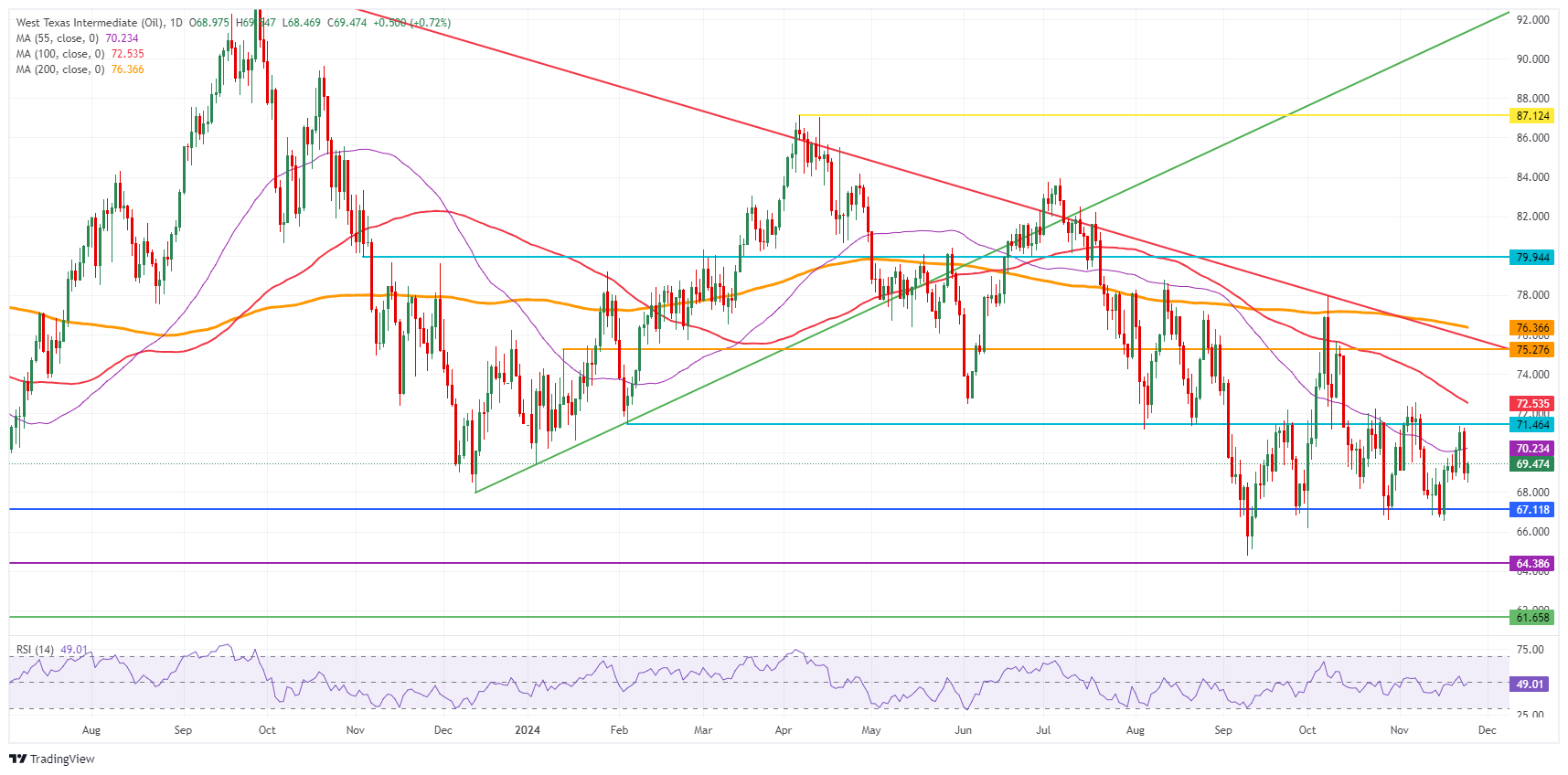- Israel has accepted in principle the US ceasefire proposal.
- President-elect Donald Trump has announced 25% tariffs on imports from Canada.
- US Dollar Index Down Slightly on New Tariffss.
Crude oil attempts to recover by jumping nearly 1% on Tuesday ahead of the American Petroleum Institute’s (API) weekly crude oil inventory change numbers. The move comes after the president-elect confirmed that he will impose 25% tariffs on goods imported from Mexico and Canada. Meanwhile, in the Middle East, Israel’s Prime Minister Benjamin Netanyahu is said to have accepted the US ceasefire proposal, which is now dependent on Hezbollah signing it before it takes effect.
The US Dollar Index (DXY), which measures the performance of the Dollar against a basket of currencies, is struggling only because the Canadian Dollar (CAD) is part of the DXY basket. A weaker CAD is being offset by a stronger Euro (EUR) and Swedish Krona (SEK) against the US Dollar. Later this Tuesday, traders will focus on the release of the Federal Reserve (Fed) minutes from the November meeting for new clues on the possibility of a rate cut in December.
At the time of writing, Crude Oil (WTI) is trading at $69.40 and Brent Crude at $73.04
Oil and markets news: OPEC+ talks intensify
- There is a strong case for the Organization of the Petroleum Exporting Countries and its allies (OPEC+) to extend their production normalization time until the second quarter of 2025 to get a clearer picture of the market, says Helima Croft, head of commodities strategy. from RBC, in a note, reported by Bloomberg.
- Russia sees its seaborne crude oil exports suffer its biggest drop since July, with shipments sliding to a two-month low. Flows to the main buyer, India, fell sharply relative to that, Reuters reports.
- Oil traders note that a risk premium on the situation in the Middle East still has room to be priced in now that a ceasefire agreement is around the corner between Israel and Hezbollah, Bloomberg reports.
- Officials from Iraq, Russia and Saudi Arabia (three of the largest OPEC+ nations) are meeting in Baghdad to discuss energy markets just days before OPEC+ holds its year-end meeting on Sunday, Bloomberg reports.
Oil Technical Analysis: Forget it
The crude oil price could enjoy an increase in volatility to enjoy some recovery. However, in the end, it seems that another delay in normalizing production will be rescheduled again by OPEC+ at its next meeting. With the Trump administration set to drill and pump more US oil, the question could arise as to whether there will ever be a normalization of production by OPEC+ in 2025.
To the upside, the 100-day SMA at $72.53 and the crucial level at $71.46 just below are the two major resistances. The 200-day SMA at $76.36 is still some way off, although it could be tested if tensions escalate further. On its rally towards that 200-day SMA, the crucial level at $75.27 could still slow any upside.
On the other hand, traders should look towards $67.12 – a level the price held in May and June 2023 – to find first support. Should that be broken, the 2024 year-to-date low emerges at $64.75, followed by $64.38, the 2023 low.
US WTI Crude Oil: Daily Chart
WTI Oil FAQs
WTI oil is a type of crude oil that is sold in international markets. WTI stands for West Texas Intermediate, one of the three main types that include Brent and Dubai crude. WTI is also known as “light” and “sweet” for its relatively low gravity and sulfur content, respectively. It is considered a high-quality oil that is easily refined. It is sourced in the United States and distributed through the Cushing facility, considered “the pipeline junction of the world.” It is a benchmark for the oil market and the price of WTI is frequently quoted in the media.
Like all assets, supply and demand are the main factors that determine the price of WTI oil. As such, global growth can be a driver of increased demand and vice versa in the case of weak global growth. Political instability, wars and sanctions can alter supply and impact prices. The decisions of OPEC, a group of large oil-producing countries, is another key price factor. The value of the US Dollar influences the price of WTI crude oil, as oil is primarily traded in US dollars, so a weaker Dollar can make oil more affordable and vice versa.
Weekly oil inventory reports published by the American Petroleum Institute (API) and the Energy Information Agency (EIA) influence the price of WTI oil. Changes in inventories reflect the fluctuation of supply and demand. If the data shows a decline in inventories, it may indicate an increase in demand, which would drive up the price of oil. An increase in inventories can reflect an increase in supply, which drives down prices. The API report is published every Tuesday and the EIA report the next day. Their results are usually similar, with a difference of 1% between them 75% of the time. EIA data is considered more reliable since it is a government agency.
OPEC (Organization of the Petroleum Exporting Countries) is a group of 13 oil-producing nations that collectively decide member countries’ production quotas at biannual meetings. Their decisions often influence WTI oil prices. When OPEC decides to reduce quotas, it can restrict supply and drive up oil prices. When OPEC increases production, the opposite effect occurs. OPEC+ is an expanded group that includes ten other non-OPEC member countries, including Russia.
Source: Fx Street
I am Joshua Winder, a senior-level journalist and editor at World Stock Market. I specialize in covering news related to the stock market and economic trends. With more than 8 years of experience in this field, I have become an expert in financial reporting.








